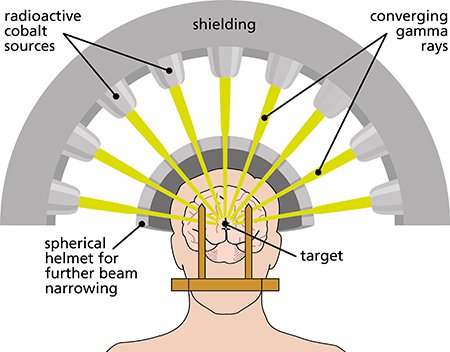| Stereotactic radiosurgery (SRS) is a non-invasive type of radiation therapy that delivers highly focused beams of radiation to a precise point in the brain to target brain tumors, including cancerous ones. Unlike traditional radiation therapy, which uses larger radiation fields over multiple sessions, SRS delivers a highly concentrated dose of radiation in a single session or a few sessions, minimizing damage to surrounding healthy brain tissue. This technique is often used for smaller brain tumors or metastases, and its effectiveness depends on factors such as tumor size, location, and type. 
Stereotactic radiosurgery (SRS) is a highly precise form of radiation therapy used to treat brain tumors and other brain lesions. Unlike traditional radiation therapy, which delivers radiation in multiple fractions over several weeks, SRS delivers a very high dose of radiation to a small, targeted area of the brain in a single session or a few sessions. This focused approach minimizes damage to the surrounding healthy brain tissue.
Here's a breakdown of key aspects of SRS for brain cancer:
How it works: - Precise Targeting: SRS uses advanced imaging techniques (like CT scans, MRI scans, and sometimes PET scans) to pinpoint the tumor's location with extreme accuracy. This information is used to plan the radiation delivery.
- High-Dose Radiation: A highly concentrated dose of radiation is delivered to the tumor, effectively destroying cancerous cells.
- Single or Few Sessions: The treatment is typically completed in one to five sessions, depending on the size and location of the tumor. This contrasts with traditional external beam radiation therapy, which requires multiple sessions over several weeks.
- Minimally Invasive: SRS is a non-invasive procedure, meaning it doesn't require surgery to access the tumor.
Types of SRS:
Several different types of technology can deliver SRS, including: - Gamma Knife: Uses multiple sources of gamma rays focused on the tumor.
- Linear Accelerator (LINAC)-based SRS: Uses a linear accelerator to deliver highly focused beams of radiation.
- CyberKnife: A robotic system that tracks the tumor's movement during treatment, allowing for highly precise radiation delivery, even in areas that move with breathing.
Uses in Brain Cancer Treatment:
SRS is often used for: - Small brain tumors: It's particularly effective for treating small, well-defined tumors.
- Brain metastases: Spread of cancer from other parts of the body to the brain.
- Benign brain tumors: Non-cancerous tumors that may still require treatment due to their location or size.
- Vascular malformations: Abnormal blood vessels in the brain.
- Trigeminal neuralgia: A nerve disorder causing severe facial pain.
Advantages of SRS: - High precision: Minimizes damage to surrounding healthy tissue.
- Less invasive: No surgery is required.
- Shorter treatment time: Compared to traditional radiation therapy.
- Outpatient procedure: Often doesn't require hospitalization.
Disadvantages of SRS: - Not suitable for all brain tumors: Larger or more diffuse tumors may not be suitable candidates.
- Potential side effects: While generally well-tolerated, side effects such as swelling, headaches, fatigue, and cognitive changes are possible. These are usually temporary.
- Cost: SRS can be expensive.
Before undergoing SRS:
Patients will undergo a thorough evaluation to determine if they are suitable candidates. This includes a complete medical history, physical examination, and various imaging tests.
Conclusion:
Stereotactic radiosurgery is a powerful tool in the treatment of brain cancer and other brain lesions. Its precision and minimally invasive nature make it a valuable option for many patients, but it's crucial to discuss the risks and benefits with a qualified oncologist and neurosurgeon to determine if it's the right treatment approach.
Tags: Brain Cancers Braub Cancer Malignant Brain Tumor SRS Stereotactic Radiosurgery  
|  1,189
1,189  0
0  0
0  3224
3224 